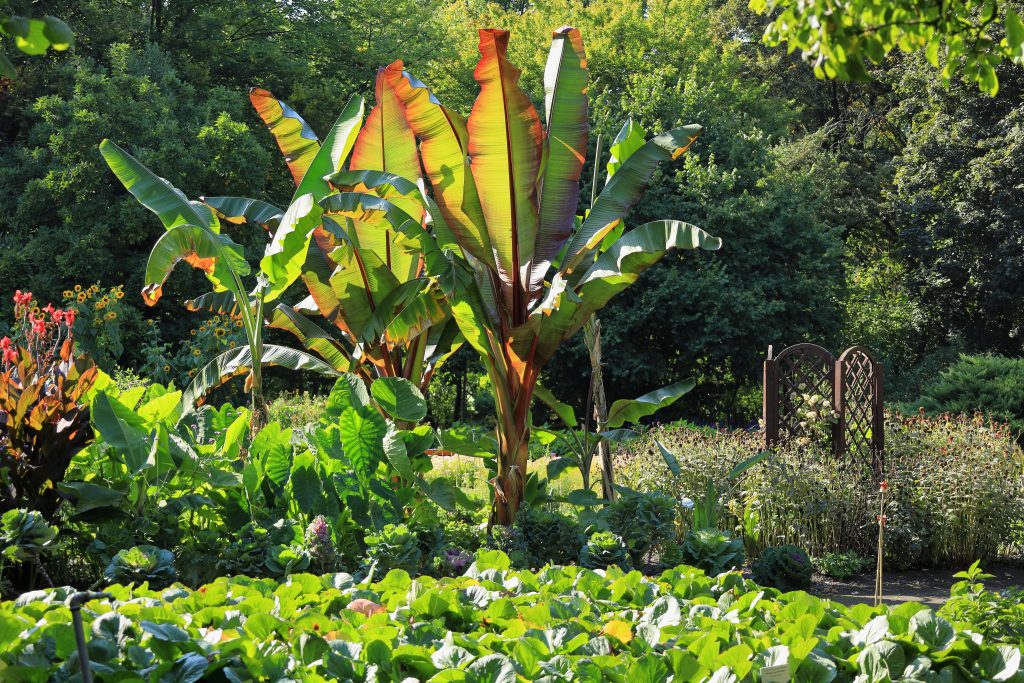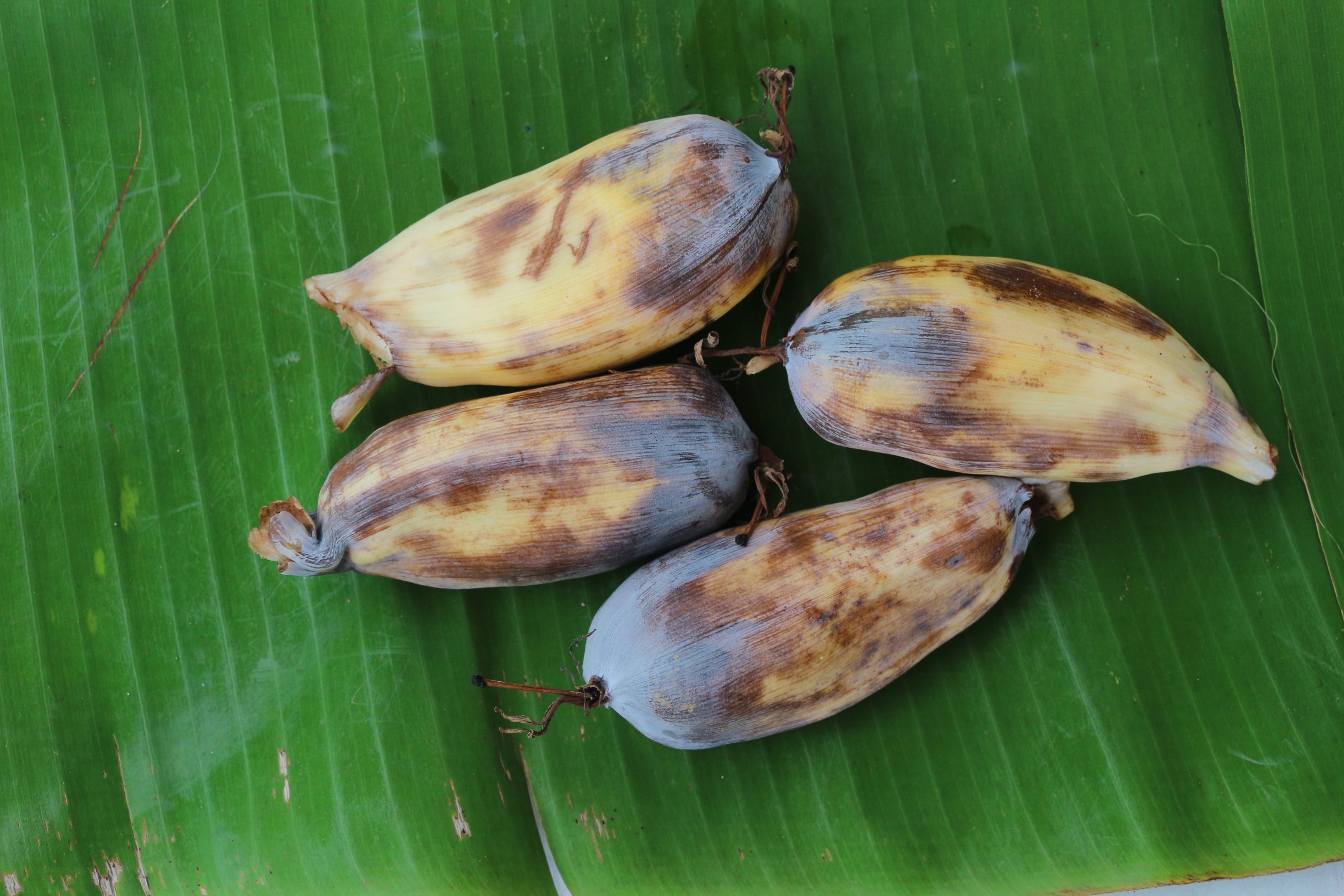Enset is particularly important in Ethiopia, serving as a significant food source and income for local communities. Enset is unique because almost every part of the plant can be used for food, making it an incredibly versatile and sustainable crop.
Table of Contents
What is an Enset?
Enset, also known as “false banana,” “Ethiopian banana,” or “Abyssinian banana,” is a large herbaceous plant native to Southern Africa and some northern parts and grown in the Ethiopian highlands. It is a starchy, carbohydrate-rich staple food crop that is similar in appearance to a banana plant.
Enset is a member of the Musaceae family, which also includes banana and plantain plants. However, unlike bananas and plantains, which produce edible fruits, enset does not have actual fruit. Instead, it produces a large, underground corm (or stem base), harvested and processed to make a starchy, bread-like food called kocho.
In terms of flavor, enset has a mild, slightly sweet taste similar to that of a potato or cassava. Its texture is dense and doughy, often served in thick, pancake-like slices that can be grilled, fried, or baked.
Enset-based dishes are typically served with savory stews or sauces, and the plant’shigh carbohydrate content makes it a filling and satisfying food. People make three main food items from enset: Kocho, Bulla, and Amicho. Kocho is the most popular and is made by fermenting the corm and pseudo-stem of the plant.
The Enset is considered a magical plant that can help fight climate change and maintain biodiversity. Diversifying farming systems is an important step that can get us there.
The History of Enset
While trekking through the marshes around Gondar, Scottish explorer James Bruce stumbled upon a curious plant that caught his eye. After much observation and research, Bruce confidently declared that this plant was “no species of Musa,” the scientific name for bananas. He also learned that the locals called it ” ensete,” which was its native name.
Years later, in 1853, the British Consul at Mussowah sent some seeds of the “ensete” plant to Kew Gardens. The Consul mentioned that the plant’s native name was “ansett,” but Kew Gardens had never heard of such a plant before.
They planted the seeds and watched in awe as the plants rapidly grew in size. Despite Bruce’s earlier declaration, it soon became apparent that these plants were related to the banana plant.
This plant also played a significant role in the mythology of Egypt. Ancient Egyptian statue carvings depict the goddess Isis sitting among the leaves of what was thought to be a banana plant. However, this was surprising because bananas were native to Southeast Asia and unknown in Ancient Egypt.

What Does Enset Taste Like?
Raw enset has a slightly bitter taste and a starchy texture. Some people compare the taste to that of unripe plantains or potatoes.
When enset is cooked, it has a softer texture and a slightly sweet, nutty flavor. Cooked enset can be used in various dishes, including porridge, bread, and stews.
Cooked enset is often enhanced by spices and other ingredients added during the cooking process to enhance the flavors of the corm.
How to Tell When Enset is Ripe
Here are some ways to tell if an enset fruit is ripe:
| Texture | The skin of a ripe enset fruit should be soft to the touch. If it is hard, the fruit is not yet ripe. |
| Firmness | A ripe enset fruit should be firm but not hard. It should give slightly when you press on it. |
| Scent | The fruit should have a sweet smell when it is ripe. If it smells sour or unpleasant, it is not yet ripe. |
| Smoothness | A ripe enset fruit should have a smooth texture outside. If it is rough or bumpy, it is not yet mature. |
| Color | A ripe enset fruit will turn yellow or orange. If it is still green, it is not yet ripe. |
Are Ensets and Bananas Related?
Ensets (Ensete ventricosum) and bananas (Musa acuminata) are both members of the Musaceae family. However, they differ in several ways.
Similarities:
- Both plants are herbaceous perennials that grow in tropical and subtropical regions.
- They have large leaves used for cooking or as a wrapping material.
Differences:
- Bananas are primarily grown for their fruit, consumed fresh or processed into various products such as dried fruit, banana chips, or banana bread. Enset, on the other hand, is grown for its starchy root or stem, a staple food in Ethiopia and parts of East Africa. The fruit is not edible.
- Bananas are generally cultivated in monoculture systems, while enset is usually intercropped with other crops, such as coffee or maize.
- The nutritional value of enset is higher than that of bananas, as the former is a good source of carbohydrates, fiber, and minerals.
- The banana plant is smaller, shorter, and thinner than the enset plant.
Can I Eat Raw Enset?
Enset Root can be consumed both raw and cooked. Here are a couple of great raw applications:
Snacking: Raw enset fruit can be peeled and eaten as a snack, much like a banana. It has a starchy, slightly sweet flavor and a chewy texture.
Salads: Thinly sliced or grated enset can be used in salads to add a unique flavor and texture. It pairs well with citrusy dressings.
Cooking with Enset
The plant is typically prepared by first scraping the interior of the corm, then soaking the remaining pulp in water. The softened pulp is then shredded and fermented for months before being used in various dishes.
In traditional Ethiopian cuisine, enset is commonly used to make a dish called ” kocho,” a type of bread made from the fermented enset pulp. Kocho is typically eaten with stews or sauces, such as “kitfo,” a dish made from minced beef, and “shiro,” a lentil-based stew.
Enset is also used in other traditional dishes such as “bulla,” a porridge-like dish made by boiling the fermented pulp with water.
In addition to its use in Ethiopian cuisine, enset is also used in other parts of Africa, such as Tanzania, Kenya, and Uganda.
Examples of enset dishes made by indigenous Ethiopians:
Unkuwa: Enset flour mixed with spices and water to make a dough, then formed into small cakes and steamed.
Itima: Enset flour is mixed with water and shaped into flat, round cakes that are then grilled or baked.
Uncca: Enset leaves and stem are chopped and cooked with spices and other ingredients to make a stew.
Doiysa uutta: Enset flour mixed with water and spices, then fried to make a type of pancake.

A traditional recipe you can try out:
Ethiopian Kocho Recipe with Enset Leaves: This traditional Ethiopian dish is tasty and highly nutritious, packed with vitamins and minerals. If you want to expand your culinary horizons and try something new and exciting, this one is worth trying!
Nutritional Benefits of Enset
As mentioned, enset is a crop grown in southwestern Ethiopia and is highly valued for its ability to provide food and nutrition to farmers and their families. While there have been some studies on the microbes present during enset fermentation, little is known.
The different clones of enset are grown for various purposes and can be processed into three main food items: Kocho, Bulla, and Amicho. These food items are highly nutritious and contain rich amounts of carbohydrates and fiber.
These carbohydrates and fibers are good for digestion and can reduce the risk of certain diseases like heart disease and colon cancer. Enset fiber also reduces the risk of developing coronary cardiovascular disease, stroke, hypertension, diabetes, obesity, and certain gastrointestinal disorders.
Enset-based foods have minerals like calcium, potassium, and zinc but have limited protein content. However, they are an excellent source of essential amino acids such as lysine and Leucine. Lysine is involved in collagen formation, and Leucine is involved in protein synthesis.
The Other Uses of Enset
Enset is a versatile plant with a wide range of uses beyond its value as a food crop:
Ornamental purposes: One of the lesser-known uses of enset is as an ornamental plant. The plant’s large, green leaves and striking inflorescence make it an attractive addition to gardens and landscapes. In some parts of Ethiopia, enset is used to decorate homes and public spaces during festivals and celebrations.
Making ropes, twines, and other woven products: The fibers are extracted from the plant’splant’s stem and processed to remove the outer layers of tissue. The resulting fibers are then spun into yarn or woven into fabric. Enset fibers are prized for their strength, durability, and water resistance, making them ideal for use in various outdoor applications.
Feed for livestock: The plant’s large, fleshy leaves are rich in nutrients and are a valuable source of fodder for cattle, sheep, and goats.
Mulch: The plant’s stem and leaf sheaths can also be used as mulch to enrich the soil and improve crop yields.
Where to Purchase Enset
The fruit is available year-round in Ethiopia and is not commonly exported to other countries. However, it may be possible to find enset or enset products in specialty stores focusing on Ethiopian or African cuisine, particularly in cities with large Ethiopian populations.
If you are located in Ethiopia, you can find enset in local markets and grocery stores. The best time to find it will depend on the region and local growing conditions, but enset is generally harvested throughout the year.

